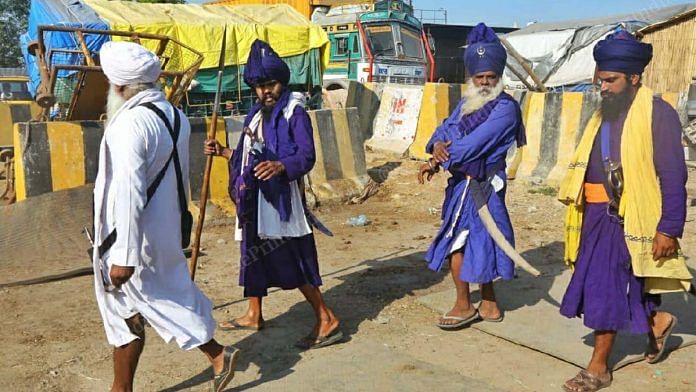Chandigarh: The brutal killing of 35-year-old Lakhbir Singh at the Singhu border, allegedly by a group of Nihangs Friday, has brought the focus back on the Sikh sect.
A group of Nihangs took responsibility for the incident in several videos that have been circulating on social media since the death of Singh, a resident of Cheema Kalan in Punjab’s Tarn Taran. He had allegedly tried to desecrate the Sarbloh Granth, a holy book of the Sikhs.
Singh’s hand and foot were cut off and he was tied to a police barricade where he reportedly bled to death. His body was discovered Friday morning.
In April 2020, during the nationwide lockdown to curb Covid, a group of Nihangs chopped off the hand of an assistant sub-inspector in Patiala. They allegedly attacked him with swords after he tried to stop their moving vehicle and asked for curfew passes.
Professor Paramjit Singh Judge of the Department of Sociology, Guru Nanak Dev University, Amritsar, who has extensively researched the origin and history of the Nihangs, notes that criminal elements have, over the years entered many Nihang deras, which have become safe houses for them.
“The Nihangs are not one consolidated sect or group. There are very divided and while following the same traditions and norms, they have their own independent deras, some of which are at loggerheads with one another for prominence,” he said.
Also read: Punjab’s frustration & anger is rooted in its steep decline, now visible in farmers’ protests
Where did the Nihangs come from?
The Nihangs trace their origins to the founding of the Khalsa Panth by the 10th guru of the Sikhs, Guru Gobind Singh, in 1699. Many claim the sect to be “guru di laadli fauj” (the guru’s favourite army).
The armed sect is believed to have emerged from the Akaal Sena, a band of soldiers of Guru Hargobind, the sixth guru. Later, the Akaal Sena metamorphosed into the ‘Khalsa Fauj’ of the 10th guru.
Nihangs played a major role in defending the Sikhs during the repeated attacks of Afghan invader Ahmed Shah Abdali in the mid-18th century. They also occupied the prime position in the army of Maharaja Ranjit Singh.
“There are several theories about the origin of the Nihangs, including the one about their having been a part of the Akaal Sena and later Khalsa Fauj. But unlike the Udasi sect and the Nirmalayas who can be clearly traced back to the Sikh gurus, there is no concrete historical evidence of the origin of the Nihangs,” says Judge.
Also read: Why Lakhimpur Kheri to Kashmir via Punjab is the road India cannot risk taking
Armed and fearless
Sikh scholar Amrit Pal Singh ‘Amrit’ writes that the word Nihang has been used in the Guru Granth Sahib (considered a living guru by Sikhs) as well as other Sikh texts. Though the word has been used in different meanings, he says, it is translated as “one being fearless and unrestrained”.
“The Nihangs know how to fight,” remarks Judge, adding they are conspicuous for their weapons and attire, and the most sought-after people during traditional religious melas in Punjab.
They are typically armed to the teeth with not just modern firearms, but also traditional weapons. These include iron bracelets or jangi kada worn around the wrist and a chakram or steel quoit around the turban. They also carry two swords or kirpans, spears and small handheld daggers. The full armour also includes a buffalo hide as a shield at the back and a chakram and iron chains around the neck.
They wear long blue robes and leather shoes called jangi moze, with a sharp metal fitting at the toe that can be used as a weapon. The most visible part of the attire is the turban, the size of which is a matter of pride — some Nihangs wear pagdis several times bigger than their heads, decorating these with the Khanda Sahib symbol of the Sikh faith.
Also Read: Bargari, Behbal Kalan, Kotkapura — sacrilege cases at centre of Sidhu-Channi discord in Punjab
The Nihang lifestyle
The Nihangs are said to have their own deras and a specific way of life.
“Those who are married are given the charge of taking care of the deras while the others move around the state. The deras have weapons, licensed firearms, horses and generally everyone undergoes martial training,” says Judge.
He says the sect has a calendar of events to attend through the year, and this includes all the important religious melas, starting with Maghi, Baisakhi, Rakhar Punia, and Diwali to Jor Mela. “They have been known to be traditional consumers of bhang or some other form of intoxicant which is taken orally, but never smoke,” says Judge.
When the Nihangs who attacked the police were arrested from their dera, the police found, apart from weapons, a large amount of ‘bhukki’ or dried opium.
“Though fragmented into several smaller groups and deras, Nihangs owe their allegiance to two broad historical divisions — the Tarna Dal and the Buddha Dal. The former included the young and the latter, the old,” explains Judge. The headquarters of the Buddha Dal is at Talwandi Sabo, while that of the Tarna Dal is at Hoshiarpur.
At any given point, large sections of the Nihangs are on the move.
“Earlier, they used to live in makeshift deras called chhaavni or cantonments. But now permanent deras have come up at many places in the state, where they live learning martial arts like gatka, horse riding and wielding weapons,” says Judge, adding most deras house gurdwaras.
To run these deras, they collect donations from nearby villages. In larger deras, attached agriculture fields are cultivated for livelihood. These ones run schools, horse riding centres and martial art academies too.






